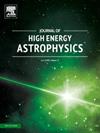Comprehensive spectro-temporal studies of GX 17+2 using AstroSat observations
IF 10.2
4区 物理与天体物理
Q1 ASTRONOMY & ASTROPHYSICS
引用次数: 0
Abstract
We performed a comprehensive spectro-temporal study of the Z-type neutron star low-mass X-ray binary GX 17+2 using long term data from the AstroSat/Soft X-ray Telescope (SXT) and Large Area X-ray Proportional Counter (LAXPC). The hardness–intensity diagrams (HIDs) of the source revealed a positive correlation between the hardness and intensity, characteristic of soft spectral state. Additionally, the LAXPC-20 HID showed the presence of secular shifts in both hardness and intensity. Time-averaged spectral modelling in the 0.7 − 30.0 keV energy range indicated that the spectra could be well fitted with the model combination: constant × edge × edge × tbabs × thcomp × bbodyrad. This analysis yielded a blackbody radius () of ∼59 km, photon index (Γ) of ∼2.84 and electron temperature () of ∼4.84 keV. Time-averaged temporal analysis revealed normal branch oscillations (NBOs) at ∼ 7 Hz in Observations 1 and 3, flaring branch oscillation (FBO) at ∼15 Hz in Observation 2, and horizontal branch oscillation (HBO) at ∼36 Hz in Observation 5. Flux resolved spectro-temporal analysis indicated that the source remained in the soft spectral state throughout all observations. A positive correlation was observed between , and , whereas an anti-correlation was noted between and . The constant frequency of NBOs with an increase in suggests that their origin lies in a region strongly influenced by the corona, as explained by the radiation-hydrodynamic model. The origin of FBOs may be attributed to the damped radiation-hydrodynamic mode of radial flow, while the origin of HBOs is supported by the beat-frequency model.
利用AstroSat观测对gx17 +2进行全面的光谱-时间研究
利用AstroSat/软x射线望远镜(SXT)和大面积x射线比例计数器(LAXPC)的长期数据,对z型中子星低质量x射线双星GX 17+2进行了全面的光谱-时间研究。光源的硬度-强度图(HIDs)显示硬度与强度呈正相关,具有软光谱状态的特征。此外,LAXPC-20 HID显示硬度和强度存在长期变化。0.7 ~ 30.0 keV能量范围内的时间平均光谱模型表明,光谱可以很好地拟合为常数×边缘×边缘× tab × comp × bbodyrad模型组合。该分析得出黑体半径(Rbb)为~ 59 km,光子指数(Γ)为~ 2.84,电子温度(kTe)为~ 4.84 keV。时间平均时间分析显示,在观测1和3中,正常分支振荡(NBOs)频率为~ 7 Hz,在观测2中,发散分支振荡(FBO)频率为~ 15 Hz,在观测5中,水平分支振荡(HBO)频率为~ 36 Hz。通量分辨光谱-时间分析表明,整个观测过程中源始终处于软光谱状态。kTbb、Fbb与Fbol呈显著正相关,kTe与Fbol呈显著负相关。nbo的恒定频率和Fbol的增加表明它们的起源位于受日冕强烈影响的区域,正如辐射-流体动力学模型所解释的那样。fbo的起源可能归因于径向流的阻尼辐射-水动力模式,而hbo的起源则得到了热频模型的支持。
本文章由计算机程序翻译,如有差异,请以英文原文为准。
求助全文
约1分钟内获得全文
求助全文
来源期刊

Journal of High Energy Astrophysics
Earth and Planetary Sciences-Space and Planetary Science
CiteScore
9.70
自引率
5.30%
发文量
38
审稿时长
65 days
期刊介绍:
The journal welcomes manuscripts on theoretical models, simulations, and observations of highly energetic astrophysical objects both in our Galaxy and beyond. Among those, black holes at all scales, neutron stars, pulsars and their nebula, binaries, novae and supernovae, their remnants, active galaxies, and clusters are just a few examples. The journal will consider research across the whole electromagnetic spectrum, as well as research using various messengers, such as gravitational waves or neutrinos. Effects of high-energy phenomena on cosmology and star-formation, results from dedicated surveys expanding the knowledge of extreme environments, and astrophysical implications of dark matter are also welcomed topics.
 求助内容:
求助内容: 应助结果提醒方式:
应助结果提醒方式:


